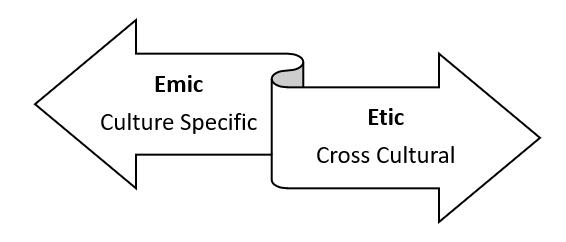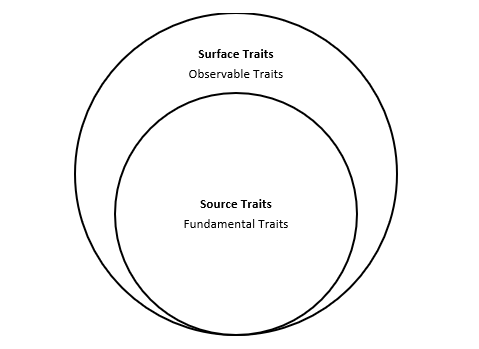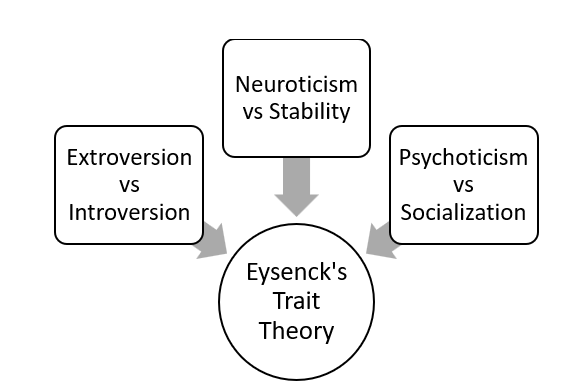Introduction
Personality is multidimensional concept. It is unique set of traits, behaviors and characteristics that define who we are and how respond with our surroundings. Here, we will see definitions, nature, characteristics of personality, personality tests with the help of authentic sources.
Meaning.
“Personality” word comes from the Latin word “persona” which means a mask worn by an actor.
Definitions
- “Personality is the dynamic organization within the individual, of those psycho-physical systems that characterize his/her characteristic adjustment to the environment” (Allport, 1937).
- “It refers to the unique and consistent pattern of thinking, feeling, and behaving” (Pervin, 1996).
- Raymond Cattell defines personality as “the traits that predict a person’s behaviour” (Cattell, 1950).
- According to the American Psychological Association, “Personality refers to individual differences in characteristic patterns of thinking, feeling, and behaving” (APA, 2023).
- “It is the sum total of all biological, innate dispositions, impulses, tendencies, appetites and instincts of the individual and the acquired dispositions and tendencies acquired by experiences” (Prince, 1924).
- “It is the more or less stable and enduring organization of a person’s character, temperament, intellect, and physique that determine his unique adjustment to his environment” (Eysenck, 1952).
- “Personality usually refers to the distinctive patterns of behaviour (including thoughts and emotions) that characterize each individual’s adaptations to the situations of his life or her life” (Mischel, 1981).
- “It is generally defined as an individual’s unique and relatively stable patterns of behaviour, thoughts, and emotions” (Baron, 1993).
(Note: Mug up the first one for good marks in exam)
Nature or Characteristic Features
- Dynamic Organization- Psychological elements within a personality system are interrelated but not fixed; they interact and adapt to changes in the environment or personal circumstances. This means that while different aspects of personality can influence each other, they are not rigid and can evolve over time. Consider an individual who is generally introverted (a trait) but becomes more outgoing in a new social group (change in behaviour due to the dynamic interaction of traits and situation). Their introversion might be temporarily overridden by their interest in making new friends, illustrating how psychological elements dynamically interact and adapt to new contexts.
- Psycho-physical Systems- Personality traits, emotions, intellect, and character are grounded in biological processes, including neurological and endocrine systems. These psychological elements are influenced by the brain’s functioning and hormonal changes. A person with high levels of the hormone cortisol (often associated with stress) might experience higher levels of anxiety and a more neurotic personality. Conversely, someone with balanced hormone levels and effective emotional regulation may display a more stable temperament. This illustrates how psychological traits are connected to biological systems.
- Unique- Each individual has a distinct personality, shaped by a unique combination of traits, experiences, and personal history. Two siblings raised in the same environment may have different personalities due to their unique experiences and genetic predispositions. One sibling might be more outgoing due to early social experiences, while the other might be more reserved due to different social interactions or temperament.
- Consistent Pattern- An individual’s personality is reflected in consistent patterns of behaviour across different situations, meaning that they tend to react similarly in comparable circumstances. A person who is generally conscientious will consistently demonstrate organizational skills and attention to detail at work, in academic settings, and in their personal life. Their conscientiousness leads them to maintain high standards and responsibility across various domains.
- Thinking (Cognition), Feeling (Affect), Behaving (Behaviour)- Personality encompasses how people think, feel, and behave. These three aspects are interconnected and contribute to an individual’s overall personality. A person who is optimistic (cognition) might frequently feel happy and enthusiastic (affect) and engage in proactive behaviours like taking on new challenges (behaviour). This integrated approach shows how cognitive, emotional, and behavioural components work together to form a person’s personality.
Determinant
1) Biological Factors:
- Body Built,
- Physical defect,
- Physical attractiveness,
- Health Conditions
2) Psychological Factors:
- Intellectual Determinants
- Emotional Determinants
- Excessive Love and Affection
- Self-disclosure
- Aspiration and Achievements
- Achievements
- Goal Setting
3) Environmental Factors:
- Social Acceptance
- Social Deprivation
- Educational Factors
- Family Determinants
- Emotional Climate of Home and Ordinal Position
- Size of the Family

Determinants
Methods to Study Personality
- Self-report Inventories- Standardized questionnaires where individuals report on their own thoughts, feelings, and behaviours.
- Q-Sort Tests- A technique where individuals sort statements into categories based on how much they feel the statements describe them.
- Rating Scales- Tools used to assess the intensity or frequency of behaviours, feelings, or attitudes, often on a numerical scale.
- Behavioural Observations- Systematic observation of behaviour in real-life or controlled settings to gather data on actions and interactions.
- Interviews- Direct, often structured, conversations to gather detailed personal information from respondents.
- Projective Techniques- Indirect assessments where individuals respond to ambiguous stimuli, revealing unconscious thoughts or feelings (e.g., Rorschach Inkblot Test).
- Biological Measures- Assessments that use physiological or neurobiological data (e.g., brain scans, hormone levels) to understand psychological processes.
- Document Analysis- Examination of written or recorded materials to analyse historical, personal, or organizational information.
Characteristics of a ‘Good’ Personality Theory
- Understanding individual differences- A theory should explain variations in behaviour, personality, and cognition among individuals.
- Predicting behaviour- It should help predict how people will behave in different environments like home, school, work, and social settings.
- Testability- The theory should be empirically testable, allowing researchers to validate or challenge its concepts through scientific methods.
- Growth and adaptability- The theory should evolve by integrating new research findings and responding to constructive criticism over time.
- Wide applicability- It should be broadly applicable to various contexts, populations, and cultures to ensure its relevance and utility across diverse settings.
Approaches to Study Personality
- Person-Situation Interaction Approach
This approach posits that behaviour is not solely determined by inherent personality traits but is significantly influenced by the situational context. It emphasizes that behaviour can vary greatly depending on the circumstances rather than being consistent across different situations.
Consider a person who is generally introverted and shy in social settings but becomes outgoing and assertive when participating in a debate competition. The Person-Situation Interaction Approach would suggest that the change in behaviour is due to the specific situational demands of the debate, rather than a fixed trait of assertiveness.
Research by Walter Mischel (1968) demonstrated that behaviour varies significantly across different situations. Mischel’s work, particularly his “personality and assessment” book, argues that while traits can provide some predictive power, situational factors often play a crucial role in determining behaviour. His studies showed that people’s responses to similar situations could differ, challenging the idea that traits alone could predict behaviour accurately.
2. Idiographic Approach to Personality
The idiographic approach focuses on studying individuals in depth, examining their unique experiences, behaviours, and personality traits as an integrated whole. It seeks to understand the complexity of an individual’s personality by considering the interaction of various factors that make up their personal experience.
A researcher conducting a case study on a single individual who has overcome significant personal adversity might explore their unique background, experiences, and personal traits to understand how these elements interact to shape their personality and behaviour.
The work of Dan P. McAdams on narrative identity is an example of the idiographic approach. McAdams (1993) emphasized that individuals construct their identities through personal narratives, which are unique and complex. His research highlighted how studying individual life stories can provide deep insights into the development of personality.
3. Nomothetic Approach to Personality
The nomothetic approach involves studying traits and characteristics across large groups of people to identify general laws or patterns. It seeks to find commonalities among individuals, often by focusing on a single trait or a limited set of traits.
A study examining aggression across a large sample of individuals might use standardized questionnaires to measure aggression levels and analyse the results to identify common patterns or factors associated with aggression.
The research on the Big Five personality traits is an example of the nomothetic approach. McCrae and Costa’s (1997) development of the Five Factor Model involved large-scale studies across different populations to identify and validate five broad dimensions of personality (openness, conscientiousness, extraversion, agreeableness, and neuroticism). This approach provides a framework for understanding personality traits across diverse groups and has been widely used in psychological research.
Each approach offers a different perspective on understanding personality and behaviour, with the Person-Situation Interaction Approach emphasizing situational influences, the Idiographic Approach focusing on individual uniqueness, and the Nomothetic Approach seeking generalizable patterns across populations.

Approaches
Culture and Personality
The shared behaviours and customs that we learn from the various institutions in our society. e.g. religion, educational setup, government policies and ideology, nationality, race, caste, ethic group
- Emic VS Etic Approaches – An emic approach is culture-specific. It focuses on a single culture. But an etic approach is cross-cultural. It searches for similarities across cultures.

Emic vs Etic
- Individualistic and Collectivistic Cultures – The difference of centrality or focus being the autonomic individual as against the focus being the collective whole. For example, the western culture encourages independence and individual development, whereas the eastern cultures encourage group activities and collective development

Individualist vs Collectivist
Classification of Personality Theories
Trait Theories of Personality
A group of theorists believed that our personality is a combination of traits that determine our behaviour.
- Allport’s Trait Theory– Gordon Allport’s trait theory emphasizes that personality is composed of different types of traits that influence behaviour. Allport identified three categories of traits:
- Cardinal Traits- These are dominant traits that define a person’s overall behaviour and are central to their identity. They are so influential that they shape and direct all aspects of a person’s life. For example, Mother Teresa’s cardinal trait could be seen as altruism or compassion, which guided her entire life and work.
- Central Traits- These are fundamental traits that form the basic foundation of personality but are less dominant than cardinal traits. Central traits are commonly used to describe a person’s general behaviour. For instance, traits such as honesty, kindness, or assertiveness could be central traits.
- Secondary Traits- These are more specific and less consistent traits that appear in certain situations or under specific circumstances. They may not be as influential in shaping behaviour as cardinal or central traits. For example, a person may exhibit nervousness (secondary trait) only when speaking in public.

Allport’s Theory
For example- a person who is generally very compassionate (cardinal trait) may also have central traits like friendliness and empathy, and secondary traits such as an occasional nervousness in new social situations.
- Cattell’s Trait Theory- Raymond Cattell’s trait theory focuses on identifying and categorizing traits based on their significance and their influence on behaviour-
- Source Traits- These are the fundamental traits that underlie and give rise to surface traits. Source traits are more stable and deeply ingrained. Cattell identified 16 source traits that he believed were crucial in understanding personality. Examples include warmth, reasoning, and emotional stability.
- Surface Traits- These are observable traits that emerge from source traits and reflect the outward behaviour of an individual. Surface traits are more specific and less fundamental compared to source traits. For example, friendliness and talkativeness may be surface traits resulting from the underlying source trait of warmth.

Cattell’s Theory
He also gave the idea of common traits and unique traits. Common traits are those shared by many people within a culture, while unique traits are individual-specific and may not be widely shared.
For example- a person who shows a high level of warmth (source trait) might display surface traits such as being outgoing and sociable in various social situations.
- Eysenck’s Trait Theory– Hans Eysenck’s trait theory is based on a model of personality organized around three main dimensions:
- Extroversion vs. Introversion- This dimension measures the degree to which a person is outgoing and sociable versus reserved and solitary. Extroverts are characterized by their enthusiasm and assertiveness, while introverts are quieter and more reflective.
- Neuroticism vs. Stability- This dimension reflects the emotional stability of a person. High neuroticism indicates a tendency toward emotional instability, anxiety, and mood swings, while emotional stability is associated with calmness and resilience.
- Psychoticism vs. Socialization (added later)- This dimension relates to how well a person conforms to social norms. High psychoticism is associated with traits like aggressiveness and egocentricity, while low psychoticism (high socialization) reflects traits such as empathy and cooperation.

Eysenck’s Theory
For example- a person scoring high on extroversion and low on neuroticism might be outgoing and emotionally stable, whereas someone with high scores in psychoticism might show behaviours that are less socially conforming.
- McCrae and Costa’s Five Factor (Big-Five) Theory– Robert McCrae and Paul Costa’s Five Factor Theory (often referred to as the Big Five) posits that five broad dimensions encompass the majority of human personality traits:
- Openness to Experience- Reflects the extent to which a person is imaginative, curious, and open to new experiences. High openness might be seen in a person who enjoys exploring new ideas and creative endeavours.
- Conscientiousness- Indicates a person’s degree of organization, responsibility, and dependability. High conscientiousness is associated with reliability and attention to detail.
- Extraversion- Measures the level of sociability, assertiveness, and excitement-seeking behaviours. High extraversion is seen in individuals who are outgoing and energetic.
- Agreeableness- Reflects how compassionate, cooperative, and trusting a person is. High agreeableness is associated with being kind and sympathetic towards others.
- Neuroticism- Assesses emotional stability and the tendency to experience negative emotions. High neuroticism is related to feelings of anxiety and vulnerability.

Big 5 Theory
For example- two people might both score high on extraversion but differ in other traits. One might be high in openness, enjoying new experiences, while the other might be high in conscientiousness, focusing on organization and reliability.
Each theory provides a different perspective on understanding personality traits, with Allport focusing on the variety and hierarchy of traits, Cattell identifying fundamental and observable traits, Eysenck emphasizing dimensional personality factors, and McCrae and Costa offering a comprehensive model of five broad traits.
Personality Tests
There are various standard psychometric Personality tests. It means these tests have well established objectivity, Reliability, Validity and Norms. Most used personality test are-
- NEO Five Factor Inventory 3 (NEO FFI 3) by McCrea & Costa
- 16 Personality Factors by Cattel (Click Here)
- Eysenck’s’ Personality Questionnaire – Revised (EPRQ) (Click here)
References
Hall, C.S., Lindzey, G., & Campbell, J.B. (2007). Theories of Personality. 4th Edn. Wiley
Pervin, L.A. (1996). The science of personality. NY: John Wiley & Co.
Schultz, D.P & Schultz, E.S. (2005). Theories of personality. Delhi: Thomson Wadsworth.
Allport, G. W. (1937). Personality: A psychological interpretation. Henry Holt and Company.
American Psychological Association. (2023). Personality. In APA dictionary of psychology. https://dictionary.apa.org/personality
Baron, R. A. (1993). Psychology (3rd ed.). Allyn & Bacon.
Cattell, R. B. (1950). Personality: A systematic theoretical and factual study. McGraw-Hill.
Eysenck, H. J. (1952). The structure of human personality (2nd ed.). Methuen.
Mischel, W. (1981). Introduction to personality (3rd ed.). Holt, Rinehart, and Winston.
Pervin, L. A. (1996). The science of personality. John Wiley & Sons.
Prince, M. (1924). The unconscious: The fundamentals of human personality, normal and abnormal. Macmillan.
McAdams, D. P. (1993). The stories we live by: Personal myths and the making of the self. Guilford Press.
McCrae, R. R., & Costa, P. T. (1997). Personality trait structure as a human universal. American Psychologist, 52(5), 509-516. https://doi.org/10.1037/0003-066X.52.5.509
Mischel, W. (1968). Personality and assessment. Wiley.
Subscribe to Careershodh
Get the latest updates and insights.
Join 18,525 other subscribers!
Niwlikar, B. A. (2024, October 6). What is Personality? Its Definitions, Nature, Characteristics & Approaches. Careershodh. https://www.careershodh.com/personality-definitions-nature-characteristics-approaches/
